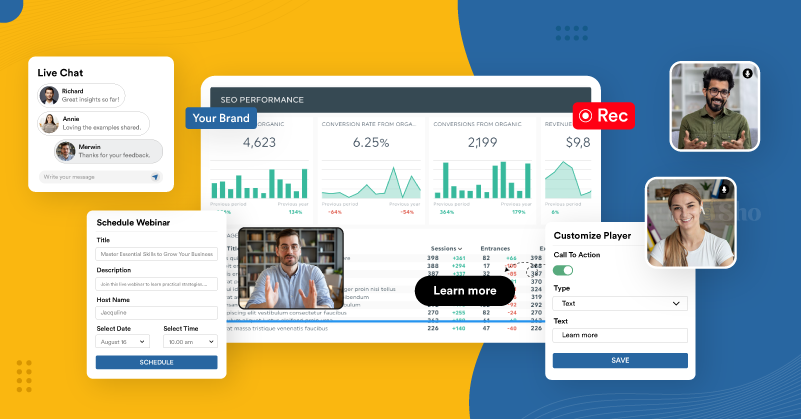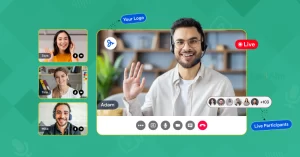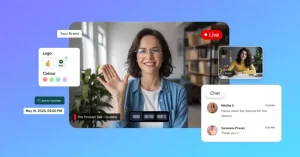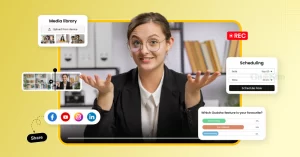Imagine a scenario where you have curated the perfect webinar with insightful takeaways, engaging speakers and an incredible topic that everyone’s talking about. But when the day comes you face a challenge, only a small number of people join your session which isn’t even close to 10%. Ever wondered why?
Typically, even the top presenters sometimes fall short to the 35% to 45% attendance benchmark. So, 64% of B2B marketers now include webinars in their strategy and conduct live events, but only a handful manage to get the average webinar attendance rate.
Want to turn in more sign-ups for your live sessions? Worry not, we have curated some simple ways to do that. With the right combination of pre-event promotion, well-timed reminders and smart scheduling, you can get more audience to show up for your live events.
In this guide, we’ll share proven tips and tricks about how to improve webinar attendance rate.
What is Webinar Attendance Rate?
Webinar attendance rate measures how many registered participants have actually joined your live session. For hosts, this matric lets you analyse and calculate the effectiveness of your promotion, timing and audience targeting. Most webinars don’t even get half of their sign ups to attend live. That’s why hitting the webinar attendance rate benchmark of 50-57% is a big deal for everyone.
How is Webinar Attendance Rate Calculated?
Attendance Rate = (Number of Attendees ÷ Number of Registrants) × 100
For example, if 100 people sign up and 50 attend, your attendance rate is 50%.
Why Does Webinar Attendance Rate Matter?
For hosts, attendance rate is more than just a headcount, it is a valuable webinar metric. It’s how you can find out if the number of registered participants actually attend your event on the given day. It even shows how your topic resonated with your audience, whether your reminders were timely and the session fit their schedules.
Low rates might indicate that the participants lost interest, weren’t given enough reminders or the timing was off for them. A high rate means participants were interested enough to join, which often indicates longer watch times, more engagement and better conversion results.
With attendance rate tracking, hosts can fine-tune content, timing and outreach so that more audiences go from “registered” to “attended.”
Here’s the Ranking of Webinar Attendance Rate
- Excellent Attendance Rate: 50% or higher
- Good Attendance Rate: 35-45%
- Average Attendance Rate: 25-35%
- Below Average Attendance Rate: 15-25%
- Poor Attendance Rate: Below 15%
Proven Techniques to Boost Your Webinar Registration
1. Define Your Audience and Webinar Objectives
Clarity is the power to every successful webinar. Show who you’re talking to, as it can be eager entrepreneurs launching their first product, small business owners looking to scale or marketing professionals refining their strategy. When you start to tailor your message according to your target audience rather than “everyone”, you can improve your average webinar attendance rate as it makes your session more engaging and relatable. Data show that targeting a focused group typically drives higher registration conversion and engagement.
2. Craft an Enticing Webinar Title
The title of your webinar is what hooks your audience’s interest. Use benefit-driven, clear, curiosity-sparking phrases like: “Click-Worthy Video Marketing Strategy to Grow Online Sales” or “Live Interactive Workshop to Scale Your Online Sales”. These sorts of value-added titles help you to grab your audience’s interests, as it is aimed at them. A strong title that is aligned with your audience’s pain points can surely increase click rates and sign-ups, leading to a solid webinar attendance rate benchmark.
3. Optimize Webinar Scheduling
Timing matters. So, before you plan your webinar, you first need to know the best time to host a webinar. Studies show that midweek days like Tuesdays, Wednesdays, and Thursdays are the busiest days for webinars due to their high watch time. Hosts should aim to schedule their webinars midday around 11 AM to 2 PM in participants’ local timezone, so more can join the session. Avoid lunch hours and Mondays/Fridays as people tend to focus on other priorities. If you want to reach global audiences, then you need to test different timeslots or run sessions in multiple time zones.
4. Create a Compelling Registration Page
Create a clean, branded landing page with key takeaways, speaker’s photo with a short bio and display testimonials or feedback to add credibility and make them register with confidence. Keep the form field to five or fewer, as simpler forms increase conversion by 10%. You can also add a CTA (Save Your Spot Now) and a countdown timer to provide a sense of urgency. There are dedicated webinar platforms that can auto-generate pages with webinar analytics for tracking and optimization.
5. Add Strategic CTAs
Bring in more registration by adding CTAs in blogs, email signatures, social profiles, posts and exit-intent popups where people are already spending their time. Also, every such soft touchpoint can drive webinar promotion and registration where potential attendees might not expect it.
6. Offer Incentives for Early Registration
Early-bird perks like eBooks, webinar replays, special access or discounted offers encourage quick sign-ups. Studies find that a free resource boosts registration rates by about 20% – 22%. These incentives create value and urgency. Their inclusion in early promotional messages helps increase your B2B webinar attendance and support follow-up actions via webinar KPIs.
Effective Webinar Promotion Strategies to Attract More Attendees
Social media buzz, personalized email campaigns, and a multi-channel strategy will drive registrations and increase your webinar attendance rates, drive engagement, and create long-term impact. Let’s see how
1. Leveraging Social Media
94% of marketers use social media to increase reach, but fewer drive registrations directly. To make it more effective, follow these:
- Post engaging content on social media platforms like LinkedIn, Twitter and Instagram to build anticipation and trigger interest for your event.
- Use targeted hashtags like #WebinarMarketing, #InteractiveWebinar or a custom tag based on your event to reach a wider audience and increase your webinar’s visibility.
2. Utilizing Email Marketing
Email remains the best tool for webinar promotion as it brings 57% of sign-ups compared to other formats. Nearly 89% of marketers consider email as the best lead generator for its ability to bring high-quality audiences. To leverage it effectively, try these:
- Send personalized invites with value messaging of what your event is about to segmented contact lists.
- Collaborate with partners or affiliates to promote your webinar via their email lists for a wider reach and trust.
3. Multi‑Channel Promotion
An effective webinar promotion strategy uses several channels such as website banners, blog posts, social media stories, WhatsApp, email sequences and partner shout-outs. With this omni-channel approach, there are several touchpoints for you to increase your webinar’s visibility and drive registrations. When you send reminders in a timely manner, you get to capture early interest and last-minute sign-ups without any hassle.
Understanding and Improving Your Webinar Attendance Rate Benchmarks
Knowing the webinar attendance rate and tracking the right webinar metrics will help you maximize the impact of your event.
1. Analyze Webinar Performance Metrics
Use built-in analytic tools to Track your webinar KPIs such as show up rate, session duration, and post-event actions to see how your audiences respond. You can also track engagement data like response rates to polls, Q&A interactions and replay views, to see how interested your audiences are in your topic.
2. Focus on Your Audience, Especially in Consumer-Oriented Webinars
Scheduling, topic relevance, and timely reminders matter more for consumer-targeted sessions. Promotional friction can reduce turnout for B2C audiences, who want more incentive and clarity on the topic. So, consumer-focused webinars are usually attended by a smaller audience unless they are tailored precisely.
To increase your live webinar attendance rate with consumer-based topics, you need to refine your target, highlight the benefits early and send timely reminders. From pre-event messaging to post-event nurturing, every touchpoint drives attendance and retention.
Implementing Strategies About How to Drive Attendance Rate
1. Timely Reminders Emails
Sending reminders to your audiences on time helps you increase your webinar attendance rate. For better results make an automated sequence that includes:
- Confirmation email/message to be sent after registration.
- Sending reminder just week before helps to build anticipation.
- A 1-day before reminder with an agenda and access link creates curiosity.
- An hour before reminder with a quick joining link helps to avoid last-minute drop-offs.
- Keep your subject line/title short, benefit-driven and clear to increase open rates and decrease no-shows.
- Add “Add-to-Calendar” links in your email to ensure easy participation.
2. Choose the Right Webinar Length
The length of a webinar directly impacts your engagement and completion rates. Studies say 45-60 minutes is the ideal sweet spot for attendee retention. When you combine optimal length and strategic scheduling which is mid-week between 11 AM to 2 PM, you can drastically increase completion and live webinar attendance percentage.
- 45-minute webinars are preferred by 44% of attendees.
- 60-minute sessions are perfect as they include depth and Q&A time.
- For industry or educational webinars, longer formats of 75-90 minutes draw more attendees.
Strategy for Creating an Engaging Webinar Content to Retain Attendees
Host an interactive webinar and increase audience retention by 23% over static sessions. By combining relevant content with timely interaction, you can make your webinars feel alive. Here’s how you make your webinar engaging:
- Between sessions, add polls and surveys to keep people interested.
- Ask real-time questions during your session to build trust, clear doubts and connect instantly.
- Encourage ongoing conversation because chat gives you energy, builds community and reduces drop off.
- Provide limited-time offers during webinars so people can feel urgency, click and convert mid-session.
- Use branded slides, infographics and visuals to keep people focused on your content.
- Share materials like cheat sheets, guides or slides as a value add to your viewers.
- Post-webinar, send e-mails with replay links and survey invites to build relationships.
Technical Aspects of Increasing Your Webinar Attendance Rate
Only if you pick the right platform and fix the technical issues immediately will your webinar attendance rate increase without drop-off. A reliable setup is what makes your sessions run smoothly and builds trust.
1. Choosing the Right Platform
Your webinar is your virtual stage. Make sure it has HD or adaptive video, real-time polling, chat, Q&A and calendar reminders for a smooth process. Also, ensure it offers detailed analytics of plays, views, attendees, drop-off points, participation and replay views to track how your session performed.
Webinar Platforms like GUDSHO, Demio, ON24 and eWebinar give you real-time webinar attendance rate and engagement dashboards for turning your online events into lead generation tools.
2. Technical Requirements
Make hosts and attendees aware of baseline technical needs:
- You need at least 2 to 5Mbps of internet speed for HD streaming. Platforms adjust to weak signals but prefer stable connections.
- Make sure the platform works on desktop, mobile and browser without any additional downloads.
- Look for a clean UI as even first-time users should be able to sign up and join with ease to reduce friction & increase attendance.
3. Troubleshooting
Be prepared for hiccups during live sessions:
- Check audio, video and sharing controls before you start hosting.
- Teach your hosts or guests some quick fixes like switching audio devices, rejoining links and using manual admits.
- Webinar platforms may delay report updates. Always check to export the attendance list manually after each session.
Bringing It All Together
Boosting your webinar attendance rate is not as overwhelming as you think. All you have to do is plan ahead, target the right people, personalize your messages & make your webinars more interactive. You can also build trust and credibility among your audience using targeted timing, engaging content, automated reminders and easy registration.
Hosts can track all your webinar KPIs like drop-off points, poll responses and viewing times to see where it lags and improve your strategy based on the data. With planned online events, having the right webinar platform and consistent follow-up can turn your attendance, engagement and conversion into a revenue driver for your business.
Recommended Reading
Frequently Asked Questions
1. How to increase webinar attendance?
You can increase your webinar attendance by doing the following after you schedule it:
🔹 Host a webinar on a trending topic with watch-worthy content.
🔹 Share a personalised landing page, registration form and email template to give viewers an engaging experience.
🔹 Promote your webinar on social media platforms to capture maximum audience attention.
🔹 Embed the scheduled webinar link on your website, blog or any webpage to expand its visibility.
2. How to increase webinar registrations?
To increase webinar registrations, create maximum awareness of your scheduled webinars through promotional activities. Platforms like GUDSHO, Wistia and others don’t require any downloads or installations, attendees can simply join the webinar by clicking the link and easily share it with friends and colleagues for quick and accelerated registration.
3. How to participate in a webinar?
Viewers can easily participate in a webinar by registering and providing basic details. They can then join the webinar studio by simply clicking the link included in the confirmation email received after registration.
4. How to promote a webinar on social media?
Promoting a webinar on social media is easy, as you can share the scheduled webinar banner or event details across your social channels.
5. How Generative AI Can Enhance Post-Webinar Activity?
You can do wonders with advanced AI features like editing your webinar recordings into social media-friendly shorts, clips and reels using powerful AI editing tools in just minutes.
6. How much does an average webinar lead cost?
Hosting webinars is one of the most cost-effective video marketing strategies for generating and converting leads. According to Visitor Queue, the average cost per lead from a webinar is $72.





The author effectively explains the importance of tracking webinar attendance because it highlights how this simple metric can uncover issues in promotion, timing, or audience interest.
By focusing on webinar performance metrics, the guide helps organizers move from just looking at registration numbers to also understanding engagement, retention, and post event actions.
Readers can better understand the average webinar attendance rate percentage since the blog explains how to calculate the rate and also clarifies what percentages are typically seen across different levels of performance.
The article highlights the value of looking at webinar performance metrics because they show not just how many people registered but also how engaged the audience was during the session.
Readers will appreciate the section that explains how to get more registrations for webinar, since practical tips on promotion and follow ups can help organizers attract a larger audience.
The post goes into detail about the show up rate, making it clear that registrations alone do not reflect success and that the real measure is how many people actually attend.